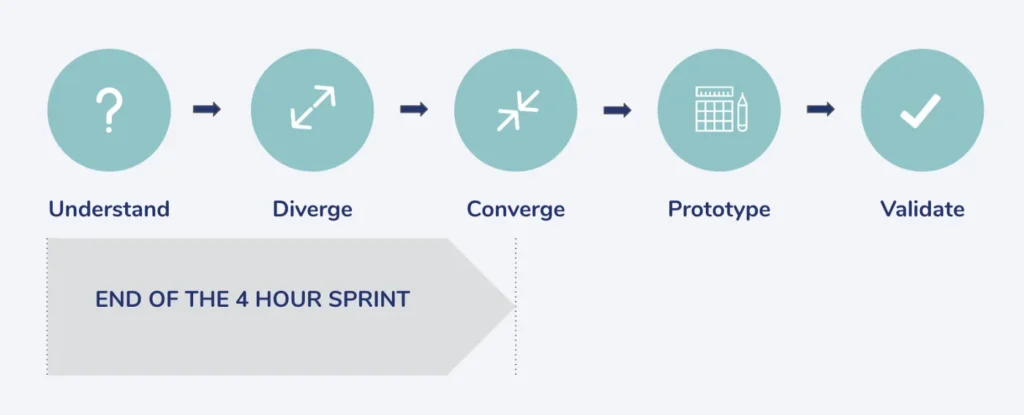João Vale
💻 Product Manager at iFood
Adapting one of Jane Austen's famous phrases: It's a universally acknowledged truth that a product team in possession of a challenge must be racing against time.

iFood
Coincidentally, in the same week that this demand arose, I received a newsletter containing the article The 4-hour design sprint , created by the Shopify team. They adapted the famous design sprint for shortened 4-hour version .
The original design sprint
For those who don't know, the design sprint is a process of five days of collaborative work , which serves to answer critical business questions through design, prototyping and testing ideas with customers. It was developed by the folks at Google Ventures.
It's a great way to validate hypotheses by investing with little time and money. If you have never participated in or heard of the design sprint, the GV website has the information you need to start one.
The scaled-down version of Shopify
In their proposal, the first 3 days of the design sprint were condensed into 4 hours. The objective is to generate as many ideas as possible in that time.
The agenda, very well structured, includes times for introduction, contextualization, individual ideation, group ideation and final presentations. In the end, the team must have enough inputs to convert into an initial proposal and start prototyping, testing or even creating a backlog.

If you are interested in testing this 4-hour design sprint, the original article brings all the dynamics in detail. Here I share some lessons learned from our experience with it.
The 4-hour sprint on iFood
As we had a smaller group, we decided to make an adjustment to the agenda proposed in the original article: instead of ideating as a group, I gave more time for participants to design their proposals individually. We then met to discuss during the final presentations.
Because of this change, we had more time to do the Crazy 8s traditional instead of the Crazy 6s proposed by the Shopify people. The rest of the sprint was very similar to their proposal, and they managed to finish on time within the expected schedule.
Tips for your 4-hour design sprint
If you're going to try a short design sprint, the following tips can help you through the process.
1. Have a clear goal in mind
It may seem obvious, but it is essential that you and all participants keep in mind what will be the deliverable of the day . Therefore, I put together a Keynote with some slides to tell the story of the problem we were working on, give context to the mechanics we were going to use and make clear the expected result of that thing.
2. Prepare a knowledge base and share it in advance
The first day of the traditional sprint is completely reserved for learning about the problem that will be worked on. In my opinion, this is one of the most important parts of the process, but unfortunately we don't have much time for this in our limited sprint.
One of the points we missed most in our experience is that all participants had an average level of knowledge on the subject.
Therefore, I recommend that you discuss some topics above and share knowledge on the subject . This will save you important discussion time during the day.
3. Does not influence participants in solutions
Right after a brief introduction, we began to list all the problems, doubts and hypotheses that could prevent us from reaching our goal. This step is extremely rich and gives us a basis for the entire process, but I noticed that, at times, the participants (including me) suggested solutions instead of listing problems or hypotheses.
The big problem here is that some solutions proposed at this stage appeared in the drawings during the ideation phase. Although they are not bad solutions, We imagine that we would have other proposals for the same problem if there were no initial influence/bias .
4. Try to converge aimlessly, but don't discard ideas
The sprint process should be centered around a problem. Its scope should not be too specific or too broad.
In our case, we were evaluating three parts of the journey of the person ordering food through the app. A very comprehensive scope. Despite this, we managed to converge and generate good proposals.
At the beginning of the dynamic, I made it clear which stages of the journey we would focus on, but we ended up coming up with good ideas for other areas of the application. Don't discard or suppress these ideas, as they could be valuable in the future and save ideation time.
5. Give participants time to settle in
The whole process went well until it was time to start drawing. At that moment, I noticed that some participants were well received, with doubts about how they should present their ideas, even though I had said at the beginning that the important thing was an idea and not the way it would be presented.
We did five Crazy 8s and only after the third did the participants manage to pick up the pace and produce more ideas. To break this initial creative block, if you have time available, I suggest start individual ideation with smaller themes so that participants feel more comfortable.
…
In the rush of everyday life, it is easy to leave the discovery phase aside and move on to solutions without carefully exploring users' problems. Our 4-hour design sprint was an important counterpoint to this. An intense experiment that brought us several lessons learned in a short space of time.

It won't be our main form of discovery from now on, but it will definitely be part of our product playbook. It is a very effective approach for specific contexts and can guide us in the right direction in times of lack of time.
…


